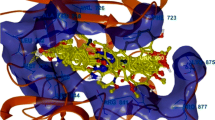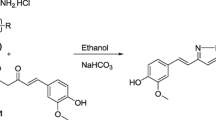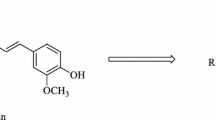Abstract
A series of novel curcumin analogues were synthesized by optimization of its aromatic ring. The antiproliferative activities of these analogues were screened against four human cancer cell lines by MTT assay and some displayed significant improvement in antiproliferative activity compared with curcumin. The most potent compound 10 exhibited antiproliferative activity against Caco-2, Bel-7402, MDA-MB-231, and DU145 cancer cells with IC50 values of 2.04, 1.54, 4.99, and 3.22 μM, respectively. Annexin V/propidium iodide double staining and flow cytometry cell cycle analysis using propidium iodide DNA staining revealed that compound 10 induced apoptosis and cell cycle arrest at G1 phase in Bel-7402 cells in a dose-dependent manner. Moreover, in an in vivo mouse model of liver cancer xenograft, compound 10 substantially inhibited liver tumor growth at a dose of 20 mg/kg/day without observable toxic effect.






Similar content being viewed by others
References
Cheng C, Jiao JT, Qian Y, Guo XY, Huang J, Dai MC, Zhang L, Ding XP, Zong D, Shao JF (2016) Curcumin induces G2/M arrest and triggers apoptosis via FoxO1 signaling in U87 human glioma cells. Mol Med Rep 13:3763–3770
Cragg GM, Newman DJ (2013) Natural products: a continuing source of novel drug leads. Biochim Biophys Acta 1830:3670–3695
Ganesan A (2008) The impact of natural products upon modern drug discovery. Curr Opin Chem Biol 12:306–317
Goldhahn K, Hintersteininger M, Steiner G, Erker T, Kloesch B (2015) Enhanced antiproliferative and pro-apoptotic activities of a novel curcumin-related compound in jurkat leukemia T-cells. Anticancer Res 35:2675–2680
Lelli D, Sahebkar A, Johnston TP, Pedone C (2016) Curcumin use in pulmonary diseases: state of the art and future perspectives. Pharmacol Res 115:133–148
Lin C, Wu X (2016) Curcumin protects trabecular meshwork cells from oxidative stress. Invest Ophthalmol Vis Sci 57:4327–4332
Liu W, Zhai Y, Heng X, Che FY, Chen W, Sun D, Zhai G (2016) Oral bioavailability of curcumin: problems and advancements. J Drug Target 24:694–702
Liu Z, Zhu YY, Li ZY, Ning SQ (2016) Eualuation of the efficacy of paclitaxel with curcumin combination in ovarian cancer cells. Oncol Lett 12:3944–3948
Mahran RI, Hagras MM, Sun D, Brenner DE (2016) Bringing curcumin to the clinic in cancer prevention: a review of strategies to enhance bioavailability and efficacy. AAPS J. doi:10.1208/s12248-016-0003-2
Makarov MV, Yu E, Anikina RV, Pukhov SA, Klochkov SG, Mischenko DV, Neganova ME, Khrustalev VN, Klemenkova ZS, Brel VK (2016) 1,5-Diaryl-3-oxo-1,4-pentadienes based on (4-oxopiperidin-1-yl)(aryl) methyl phosphonate scaffold: synthesis and antitumor properties. Med Chem Res. doi:10.1007/s00044-016-1726-4
Momtazi AA, Sahebkar A (2016) Difluorinated curcumin: a promising curcumin analogue with improved anti-tumor activity and pharmacokinetic profile. Curr Pharm Des 22:4386–4397
Newman DJ (2008) Natural products as leads to potential drugs: an old process or the new hope for drug discovery? J Med Chem 51:2589–2599
Pietenpol JA, Stewart ZA (2002) Cell cycle checkpoint signaling. Toxicology 181:475–481
Sahu PK, Sahu PK, Sahu PL, Agarwal DD (2016) Structure activity relationship, cytotoxicity and evaluation of antioxidant activity of curcumin derivatives. Bioorg Med Chem Lett 26:1342–1347
Segawa K, Nagata S (2015) An apoptotic ‘eat me’ signal: phosphatidylserine exposure. Trends Cell Biol 25:639–650
Singh H, Kumar M, Nepali K, Gupta MK, Saxena AK, Sharma S, Bedi PM (2016) Triazole tethered C5-curcuminoid-coumarin based molecular hybrids as novel antitubulin agents: design, synthesis, biological investigation and docking studies. Eur J Med Chem 116:102–115
Teymouri M, Barati N, Pirro M, Sahebkar A (2016) Biological and pharmacological evaluation of dimethoxycurcumin: a metabolically stable curcumin analogue with a promising therapeutic potential. J Cell Physiol. doi:10.1002/jcp.25749.
Wang K, Qiu F (2013) Curcuminoid metabolism and its contribution to the pharmacological effects. Curr Drug Metab 14:791–806
Wichitnithad W, Nimmannit U, Wacharasindhu S, Rojsitthisak P (2011) Synthesis, characterization and biological evaluation of succinate prodrugs of curcuminoids for colon cancer treatment. Molecules 16:1888–1900
Yu S, Wang X, He X, Wang Y, Gao S, Ren L, Shi Y (2016) Curcumin exerts anti-inflammatory and antioxidative properties in 1-methyl-4-phenylpyridinium ion (MPP(+))-stimulated mesencephalic astrocytes by interference with TLR4 and downstream signaling pathway. Cell Stress Chaperones 21:697–705
Yu X, Zhong J, Yan L, Li J, Wang H, Wen Y, Zhao Y (2016) Curcumin exerts antitumor effects in retinoblastoma cells by regulating the JNK and p38 MAPK pathways. Int J Mol Med 38:861–868
Zhu GH, Dai HP, Shen Q, Ji O, Zhang Q, Zhai YL (2016) Curcumin induces apoptosis and suppresses invasion through MAPK and MMP signaling in human monocytic leukemia SHI-1 cells. Pharm Biol 54:1303–1311
Acknowledgements
This work was supported by grants from the National Program on Key Basic Research Project (973 Program, No. 2011CB504405), the National Natural Scientific Foundation of China (No. 81372121, 81572146), and the Key Project of Shanghai Science and Technology Commission (No. 13411951002).
Author information
Authors and Affiliations
Corresponding author
Ethics declarations
Conflict of interest
The authors declare that they have no competing interests.
Electronic supplementary material
Rights and permissions
About this article
Cite this article
Zhang, L., Zong, H., Lu, H. et al. Discovery of novel anti-tumor curcumin analogues from the optimization of curcumin scaffold. Med Chem Res 26, 2468–2476 (2017). https://doi.org/10.1007/s00044-017-1946-2
Received:
Accepted:
Published:
Issue Date:
DOI: https://doi.org/10.1007/s00044-017-1946-2




